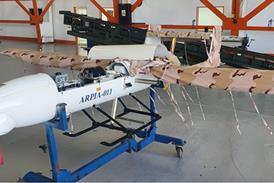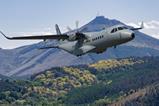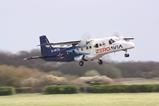A European project to design a wing for a next-generation regional turboprop is closing in on the production of a series of demonstrators that will mature the underlying technologies required.
Called HERWINGT, the Clean Aviation-funded project’s goal is to design a lightweight, low-drag wing capable of supporting a hybrid-electric powertrain. Is targeting a wing that is 15% more fuel efficient and 20% lighter at component level than current state-of-the-art designs.

Running since January 2023, and coordinated by Airbus Defence & Space in Spain, HERWINGT now has a little over a year left before its conclusion at the end of October 2026.
Disclosing the latest progress in a newsletter released on 1 July, the HERWINGT project says the definition phase for the demonstrators – 23 “enabling technologies” will be tested across 16 physical and four virtual demonstrators – “is close to completion”.
Critical design reviews (CDRs) for “essential components” were concluded “in the final weeks of 2024”, building on the finalisation of preliminary design review activities in mid-2024.
Following the CDRs, changes were made to the centre wing box demonstrator, which required “reinforcement at the interfaces with the load introduction actuators”, the newsletter discloses.
Nickel has also been selected as the material for the induction ice-protection system, which will be integrated into the “multi-functional” wing leading edge.
A 2.4m (7ft 9in)-long structure, the leading edge demonstrator features a solid laminate construction “optimised for bird-strike resistance, ice protection system (IPS) integration, and erosion durability” and should require “minimal assembly”.
Images displayed in the newsletter show the upper and lower skins are 2.5mm-thick material, while the front of the leading edge is 8mm thick. Total weight for the demonstrator, including its three integrated carbonfibre ribs, will be a little over 21kg (46lb).
HERWINGT will evaluate the effectiveness of the integrated IPS in an ice windtunnel, it says, with the specification for that testing now “formally approved”.
In all, the project is working on three different leading edge demonstrators, with additional components designed to demonstrate manufacturing or weight-saving composite technologies.
HERWINGT has also been examining three “innovative” configurations: a strut-braced-wing (SBW) design, with a high aspect ratio; a cantilevered high aspect-ratio wing; and a wing integrated with distributed propulsion systems.
“Aerodynamic shaping and aeroelastic optimisation have been completed for cruise flight conditions,” the project says.
Additionally, the geometry for the SBW design “has been further refined to enhance low-speed stall characteristics in a clean configuration”, while high-lift devices have been “aerodynamically optimised” to improve performance during take-offs and landings, it adds.
Of the 23 enabling technologies being developed through the project, the majority reached technology readiness level (TRL) 3 during 2024, says HERWINGT.
“Progress continued into 2025, with TRL4 evaluations conducted during the first quarter, marking a significant step forward in technology maturation,” it adds.
Clean Aviation allocated €21 million ($25 million) to the project under its first phase. Although wing technology was not a focus of a recent call for proposals – the start of phase 2 activities – a follow-on to HERWINGT, likely requiring a full wing demonstrator, could gain funding in subsequent calls planned for 2026 and 2027.































